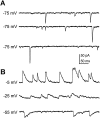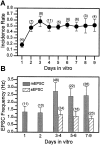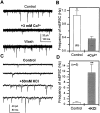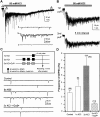Fast excitatory synaptic transmission mediated by nicotinic acetylcholine receptors in Drosophila neurons
- PMID: 10377342
- PMCID: PMC6782340
- DOI: 10.1523/JNEUROSCI.19-13-05311.1999
Fast excitatory synaptic transmission mediated by nicotinic acetylcholine receptors in Drosophila neurons
Abstract
Difficulty in recording from single neurons in vivo has precluded functional analyses of transmission at central synapses in Drosophila, where the neurotransmitters and receptors mediating fast synaptic transmission have yet to be identified. Here we demonstrate that spontaneously active synaptic connections form between cultured neurons prepared from wild-type embryos and provide the first direct evidence that both acetylcholine and GABA mediate fast interneuronal synaptic transmission in Drosophila. The predominant type of fast excitatory transmission between cultured neurons is mediated by nicotinic acetylcholine receptors (nAChRs). Detailed analysis of cholinergic transmission reveals that spontaneous EPSCs (sEPSCs) are composed of both evoked and action potential-independent [miniature EPSC (mEPSC)] components. The mEPSCs are characterized by a broad, positively skewed amplitude histogram in which the variance is likely to reflect differences in the currents induced by single quanta. Biophysical characteristics of the cholinergic mEPSCs include a rapid rise time (0.6 msec) and decay (tau = 2 msec). Regulation of mEPSC frequency by external calcium and cobalt suggests that calcium influx through voltage-gated channels influences the probability of ACh release. In addition, brief depolarization of the cultures with KCl can induce a calcium-dependent increase in sEPSC frequency that persists for up to 3 hr after termination of the stimulus, illustrating one form of plasticity at these cholinergic synapses. These data demonstrate that cultured embryonic neurons, amenable to both genetic and biochemical manipulations, present a unique opportunity to define genes/signal transduction cascades involved in functional regulation of fast excitatory transmission at interneuronal cholinergic synapses in Drosophila.
Figures











Similar articles
-
Fast synaptic currents in Drosophila mushroom body Kenyon cells are mediated by alpha-bungarotoxin-sensitive nicotinic acetylcholine receptors and picrotoxin-sensitive GABA receptors.J Neurosci. 2003 Oct 8;23(27):9246-53. doi: 10.1523/JNEUROSCI.23-27-09246.2003. J Neurosci. 2003. PMID: 14534259 Free PMC article.
-
cAMP-dependent plasticity at excitatory cholinergic synapses in Drosophila neurons: alterations in the memory mutant dunce.J Neurosci. 2000 Mar 15;20(6):2104-11. doi: 10.1523/JNEUROSCI.20-06-02104.2000. J Neurosci. 2000. PMID: 10704484 Free PMC article.
-
Differential modulation of nicotinic acetylcholine receptor subtypes and synaptic transmission in chick sympathetic ganglia by PGE(2).J Neurophysiol. 2001 Jun;85(6):2498-508. doi: 10.1152/jn.2001.85.6.2498. J Neurophysiol. 2001. PMID: 11387396
-
Multiple mechanisms of fast excitatory synaptic transmission in the enteric nervous system.J Auton Nerv Syst. 2000 Jul 3;81(1-3):97-103. doi: 10.1016/s0165-1838(00)00130-2. J Auton Nerv Syst. 2000. PMID: 10869707 Review.
-
Calcium dependence of spontaneous neurotransmitter release.J Neurosci Res. 2018 Mar;96(3):335-347. doi: 10.1002/jnr.24116. Epub 2017 Jul 12. J Neurosci Res. 2018. PMID: 28699241 Free PMC article. Review.
Cited by
-
Cholinergic Homeostatic Synaptic Plasticity Drives the Progression of Aβ-Induced Changes in Neural Activity.Cell Rep. 2018 Jul 10;24(2):342-354. doi: 10.1016/j.celrep.2018.06.029. Cell Rep. 2018. PMID: 29996096 Free PMC article.
-
Activation of cyclic AMP signaling pathway in dopaminergic neurons rescues locomotion defects in a Drosophila larval model of Parkinson's disease.Brain Res. 2024 Jan 1;1822:148641. doi: 10.1016/j.brainres.2023.148641. Epub 2023 Oct 21. Brain Res. 2024. PMID: 37866407 Free PMC article.
-
Linking aβ42-induced hyperexcitability to neurodegeneration, learning and motor deficits, and a shorter lifespan in an Alzheimer's model.PLoS Genet. 2015 Mar 16;11(3):e1005025. doi: 10.1371/journal.pgen.1005025. eCollection 2015 Mar. PLoS Genet. 2015. PMID: 25774758 Free PMC article.
-
Membranes with the same ion channel populations but different excitabilities.PLoS One. 2012;7(4):e34636. doi: 10.1371/journal.pone.0034636. Epub 2012 Apr 16. PLoS One. 2012. PMID: 22523552 Free PMC article.
-
Developmental experience-dependent plasticity in the first synapse of the Drosophila olfactory circuit.J Neurophysiol. 2016 Dec 1;116(6):2730-2738. doi: 10.1152/jn.00616.2016. Epub 2016 Sep 28. J Neurophysiol. 2016. PMID: 27683892 Free PMC article. Review.
References
-
- Banker G, Goslin K. Culturing nerve cells. Cellular and molecular neuroscience series. MIT; Cambridge, MA: 1991.
-
- Bekkers JM, Stevens CF. NMDA and non-NMDA receptors are co-localized at individual excitatory synapses in cultured rat hippocampus. Nature. 1989;341:230–233. - PubMed
-
- Bertrand D, Ballivet M, Gomez M, Bertrand S, Phannavong B, Gundelfinger ED. Physiological properties of neuronal nicotinic receptors reconstituted from the vertebrate β2 subunit and Drosophila α-subunits. Eur J Neurosci. 1994;6:869–875. - PubMed
Publication types
MeSH terms
Substances
Grants and funding
LinkOut - more resources
Full Text Sources
Molecular Biology Databases
